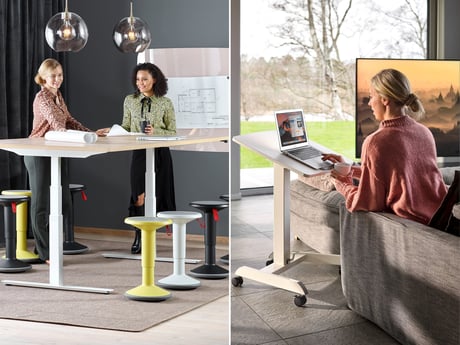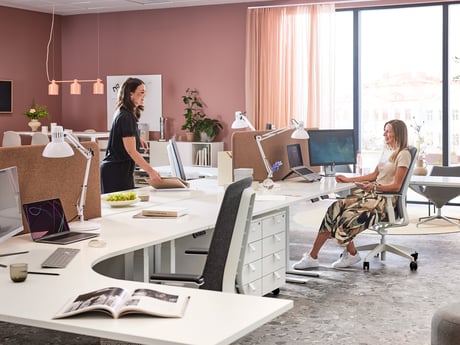- AJ Products UK
- Blog: Tips to Inspire Happiness at Work
- Improving the work environment
- How to adapt your office space to suit post-pandemic working patterns
How to adapt your office space to suit post-pandemic working patterns
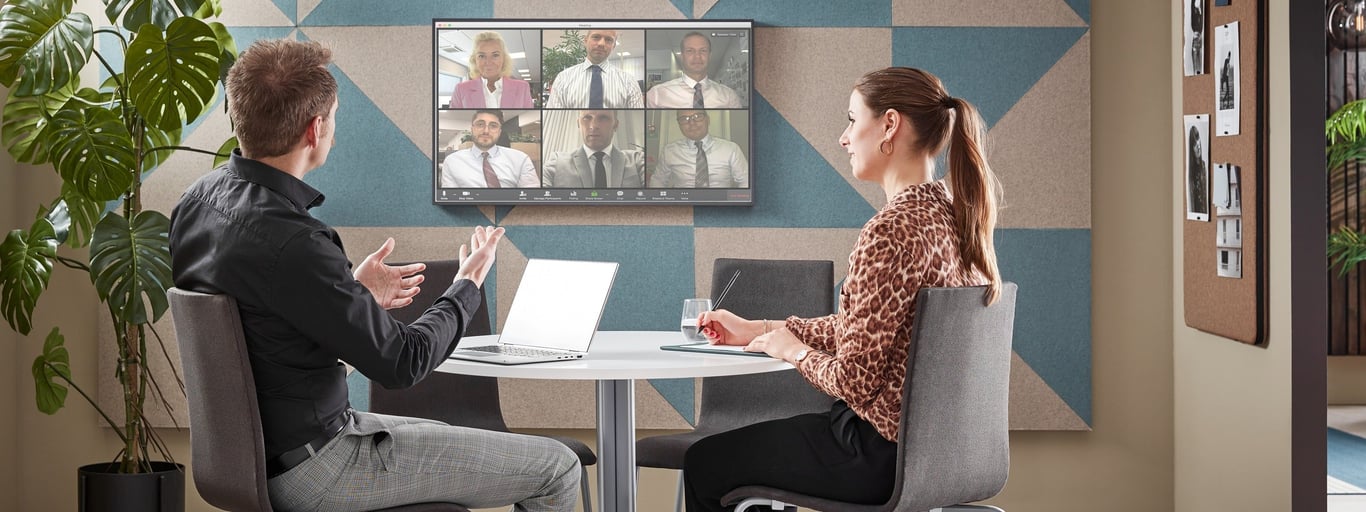
The pandemic changed the way we work and taught us that teams can operate effectively with remote staff. As a result, some companies downsized their offices or gave up physical workspaces altogether.
Many of the adaptations introduced during the pandemic have outlived social distancing. Some of the safety measures put in place at the time have since evolved into long-term strategies for wellbeing, productivity and hybrid working - such as smarter layouts and more flexible protocols
In this article, we explore how to make the most of your space and futureproof your office to meet the needs of today’s workforce.
To make the most of remote working, many companies are embracing a combination of remote and on-site working, giving rise to a hybrid work model. The concept helps reduce overhead costs for businesses while giving employees more flexibility in how and where they work.
How can you optimise your remaining office space?
Desks: From separation to smart zoning
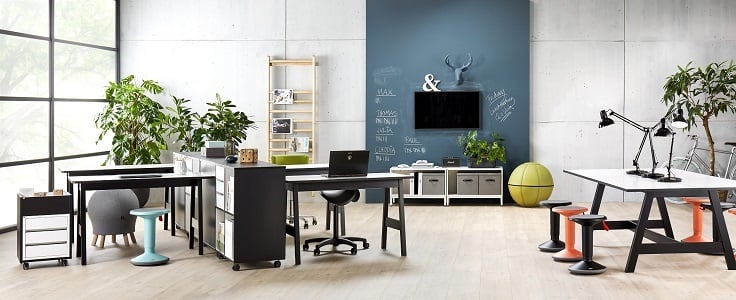
During the pandemic, assigned desks and physical separation became essential for safety. Today, those same principles are helping businesses support hybrid working and create a more comfortable, considered environment. Office design is shifting towards zoned layouts that support a range of activities - from quiet, focused work to collaborative catch-ups.
Rather than uniform rows of benches, many organisations now prefer a mix of individual desks, acoustic pods and agile furniture that can be reconfigured as needed.
Hot desking has also made a comeback, this time with improved hygiene protocols and personal storage to make it more practical and appealing. Clearly defined work zones help hybrid teams collaborate without overcrowding, offering flexibility while maintaining structure. It’s all about giving people space to work productively, without losing the buzz of being together.
Collaborative spaces: Designed for in-person value
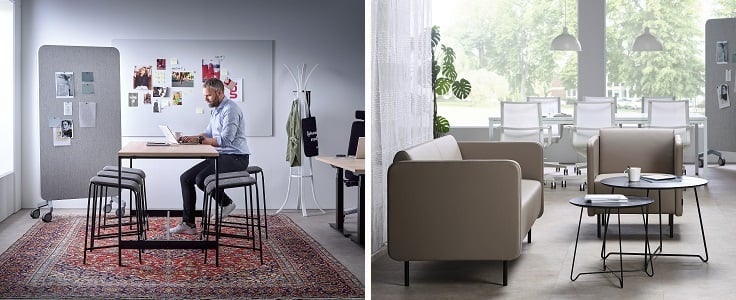
If staff are working only part-time in the office, then in-person meetings and team projects should be prioritised on those days, with individual tasks left for remote working days. In order to encourage and facilitate this, the office could be redesigned to get rid of cubicles and individual workspaces and instead create more collaborative meeting spaces. This doesn’t have to mean formal conference rooms. In fact, casual meeting spaces that offer plenty of flexibility are often more effective as they can be adapted to current needs and allow for a more relaxed and creative atmosphere.
Try to provide a variety of different collaborative spaces throughout the office. Choose office furniture that is easy to move around and provide several different seating options so employees can reconfigure the space to suit their purpose. An effective collaboration area will strike a balance between comfort and practicality. Think about connectivity: having fast WiFi and plenty of accessible power outlets is essential so that employees can charge their laptops and mobile devices while they work.

Storage: Supporting hot desking and hybrid routines
Without allocated desk spaces, lockable personal storage on-site will be essential to allow staff to store their belongings safely along with any IT equipment or paperwork that they don’t want to take back and forth from home to the office with them.
Smart personal storage lockers can be both a practical and stylish addition to the office space. Think about the needs of your employees. Do you just want them to be able to store the contents of their desk overnight? If they won’t have a desk space during the day, should they be able to fit their bag in the locker too? Should some lockers be big enough to fit a bike helmet or gym kit? Decide in advance whether each member of staff will have their own locker or if lockers will be allocated per day (like in the gym).
Depending on how you will allocate lockers, different types of locks are available; smart lockers - with keypads, fobs or app-based access - offer flexibility and help maintain a tidy, organised space.
Quiet zones for virtual meetings
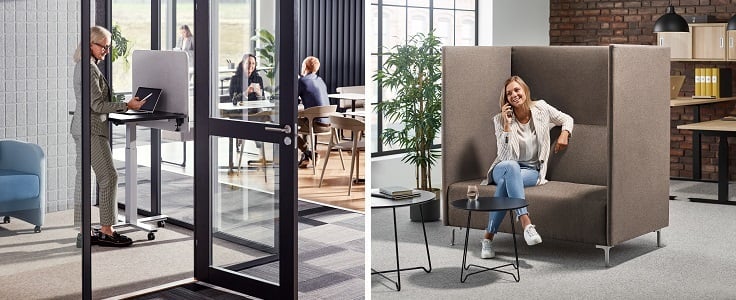
Even as employees return to the office and are able to arrange in-person meetings with colleagues, virtual meetings continue to play a significant role. Many companies have reduced business travel, replacing in-person meetings with video calls - saving time, cost and emissions. It is important to accommodate these meetings in the office by providing quiet zones with good acoustics where employees can speak without disturbing their colleagues and where background noise will not feed back and affect their ability to hear and talk in the meeting. This may include adding acoustic meeting booths, huddle rooms or soundproof pods to your open office space.
Screens: From barriers to privacy and focus tools
While we may no longer need Perspex screens for health and safety, desk and floor screens still play a valuable role in today’s offices. Acoustic and fabric desk screens help reduce visual and noise distractions, making open-plan spaces more conducive to focused work. They also provide a subtle sense of personal space, something many employees appreciate, especially in hybrid or shared-desk environments.
Floor screens, meanwhile, have evolved into versatile zoning tools. They can be used to divide departments, create quiet corners or separate walkways from workstations improving layout and flow. Many are now designed with sound-dampening materials, helping to minimise background noise and support better concentration. Acoustic screens are key to designing flexible, multi-functional workplaces allowing you to create improvised meeting spaces or shielding relaxation areas.
Signage: From safety reminders to wayfinding
One thing the pandemic taught us is the importance of clear, consistent communication in shared spaces. While 2-metre markers and hygiene reminders may no longer be front and centre, signage still plays a vital role in guiding people through the workplace. Whether it’s wayfinding, room booking, or gentle reminders about shared space etiquette, the right signs help ensure everyone’s on the same page - without disrupting the flow of the day.
Today’s signage is more considered and less clinical. From stylish wall graphics to digital displays, businesses are using visual cues to share messages clearly and efficiently, whether that’s directing foot traffic, identifying zones or reinforcing company values. It’s about making information easy to find, intuitive to follow, and aligned with the overall look and feel of the space.
Flexible protocols: From temporary measures to permanent perks
Staggered hours, remote meetings and enhanced cleaning have become part of a modern, considerate workplace. These habits support work-life balance, reduce unnecessary stress and contribute to a healthier environment overall.
Adapting your workspace for wellbeing, flexibility and flow isn’t just about reacting to a crisis, it’s about futureproofing for productivity, safety and satisfaction.
Want to rethink your space? Let us help you create a workplace that works for everyone.
